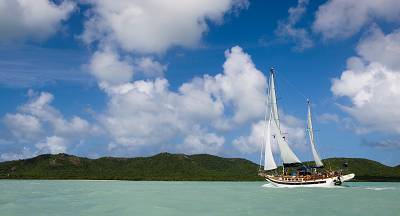Having a sailboat during a disaster can offer several benefits for individuals and communities affected by a crisis. Here are some of the main advantages of having a sailboat during a disaster:
-
Mobility: In a disaster situation, mobility and flexibility is often critical for reaching safety or providing assistance to others. A disaster area may be inaccessible to cars or trucks, such as flooded streets, damaged roads, or areas with limited infrastructure. A sailboat is not dependent on roads or other infrastructure, which can be damaged or blocked during a disaster. Having a mobile and flexible form of transportation, such as a sailboat, can allow you to bypass these obstacles and reach your destination more quickly and safely. It can navigate through shallow waters, go around debris or other obstacles, and even sail upwind, allowing it to access areas that might be difficult or impossible to reach by other means. This can be particularly useful for evacuating individuals or transporting supplies to areas that are difficult to access.
Mobility and flexibility are crucial because they allow you to adapt and respond to rapidly changing conditions, and provide options for evacuation, relocation, and access to resources.
-
![]() Self-sufficiency: A sailboat can carry its own supplies, including food, water, and fuel, which can be critical during a disaster. When a disaster strikes, infrastructure and supply chains can be disrupted, making it difficult or impossible to access food, water, medical supplies, and other basic necessities. For example, if there is a shortage of fresh water, a sailboat can use a watermaker to produce drinkable water from seawater. It can also generate its own power through renewable energy sources such as solar panels or wind turbines, reducing the need for gasoline or diesel fuel. In these situations, having the ability to generate and store your own resources can increase your chances of survival and reduce the strain on limited resources.
Self-sufficiency: A sailboat can carry its own supplies, including food, water, and fuel, which can be critical during a disaster. When a disaster strikes, infrastructure and supply chains can be disrupted, making it difficult or impossible to access food, water, medical supplies, and other basic necessities. For example, if there is a shortage of fresh water, a sailboat can use a watermaker to produce drinkable water from seawater. It can also generate its own power through renewable energy sources such as solar panels or wind turbines, reducing the need for gasoline or diesel fuel. In these situations, having the ability to generate and store your own resources can increase your chances of survival and reduce the strain on limited resources.Self-sufficiency can also increase resilience, as it allows individuals and communities to continue functioning even in the absence of external support. This can reduce the burden on emergency responders and increase the ability of communities to support each other during a crisis.
Self-sufficiency is important in a disaster scenario because it allows individuals and communities to be more self-reliant and adaptable, and increases the chances of survival and recovery in the face of a crisis. This self-sufficiency can make a sailboat a viable option for long-term survival during a disaster.
-
Versatility: A sailboat can be used for many different purposes during a disaster. For example, it can serve as a temporary shelter for individuals who have lost their homes. It can also be used as a command center for search and rescue operations, allowing rescue workers to coordinate efforts from a safe location. It can also be used as a mobile medical center, treating people in hard to reach places. Additionally, a sailboat can be used to transport equipment or supplies, such as medical supplies or food, to areas that are difficult to access.
-
Sustainability & Resilience: A sailboat is a sustainable form of transportation and survival, which can be important in disaster situations where traditional forms of transportation may be limited or unavailable. In the event of a power outage, a sailboat can still function as long as there is wind to power the sails. This makes it a more resilient form of transportation and shelter during a disaster.
By using renewable energy sources such as wind and solar power, a sailboat can reduce its environmental impact and provide a more sustainable alternative to gasoline or diesel-powered boats.
![]()
-
Safety: In some disaster scenarios, a sailboat may be the safest place to be. For example, if there is a risk of flooding in a coastal area, a sailboat can be used to sail out to deeper waters and ride out the storm. Additionally, a sailboat can provide a secure and stable platform for conducting search and rescue operations or providing medical assistance.
- Access to Resources: A sailboat can provide access to resources that may not be available on land, such as fresh fish and other marine life. Additionally, sailors may be able to navigate to areas where supplies are more readily available.
Access to resources can help ensure the survival and well-being of individuals and communities affected by a crisis. Disasters can cause significant damage to infrastructure and disrupt supply chains, making it difficult to access essential resources such as food, water, medical supplies, and shelter. In these situations, having access to resources can be critical to survival.
Access to resources can take many forms. For example, having access to safe drinking water, food supplies, and medical resources can help individuals and communities maintain their physical health and well-being. Having access to shelter and housing can provide protection from the elements and a safe place to sleep. Access to communication resources such as radios or cell phones can also be important for staying informed and connected during a crisis.
In addition to providing for immediate needs, access to resources can also be important for long-term recovery. For example, access to financial resources and support can help individuals and communities rebuild damaged homes and businesses, while access to job training and employment resources can help individuals and communities recover economically.
Access to resources is vital in a disaster scenario because it can help ensure the survival and well-being of individuals and communities affected by a crisis. By having access to essential resources and support, individuals and communities can improve their chances of survival, recovery, and long-term resilience.
Overall, having a sailboat during a disaster can provide a wide range of benefits for individuals and communities affected by a crisis. By providing a mobile, self-sufficient, versatile, safe, and sustainable form of transportation and survival, a sailboat can improve the chances of survival, recovery, and long-term resilience.
In summary, the benefits of having a sailboat during a disaster include mobility, self-sufficiency, versatility, sustainability & resilience, safety, and access to resources. These benefits can improve the chances of survival and recovery for individuals and communities affected by a crisis, making a sailboat a valuable asset in disaster preparedness planning.

 Self-sufficiency: A sailboat can carry its own supplies, including food, water, and fuel, which can be critical during a disaster. When a disaster strikes, infrastructure and supply chains can be disrupted, making it difficult or impossible to access food, water, medical supplies, and other basic necessities. For example, if there is a shortage of fresh water, a sailboat can use a watermaker to produce drinkable water from seawater. It can also generate its own power through renewable energy sources such as solar panels or wind turbines, reducing the need for gasoline or diesel fuel. In these situations, having the ability to generate and store your own resources can increase your chances of survival and reduce the strain on limited resources.
Self-sufficiency: A sailboat can carry its own supplies, including food, water, and fuel, which can be critical during a disaster. When a disaster strikes, infrastructure and supply chains can be disrupted, making it difficult or impossible to access food, water, medical supplies, and other basic necessities. For example, if there is a shortage of fresh water, a sailboat can use a watermaker to produce drinkable water from seawater. It can also generate its own power through renewable energy sources such as solar panels or wind turbines, reducing the need for gasoline or diesel fuel. In these situations, having the ability to generate and store your own resources can increase your chances of survival and reduce the strain on limited resources.